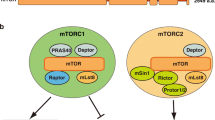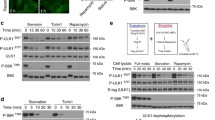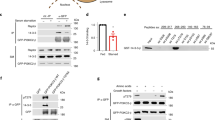Abstract
The mammalian target of rapamycin (mTOR) is a key regulator of cell growth that integrates signals from growth factors and nutrients. Recent studies have shown that an mTOR-containing complex, mTORC1, is targeted to lysosomes in the presence of amino acids and activated by Rheb GTPase resident in that compartment. In this study, we found that treatment with the mTOR inhibitors rapamycin and Torin1 significantly enhanced lysosomal accumulation of mTOR and Raptor. This phenomenon was not observed in the absence of amino acids but was restored upon addition of l-leucine or protein synthesis inhibitors. mTOR was not concentrated in autophagosomes that were induced by rapamycin. These results suggest that the lysosome harbors both active and inactive forms of mTOR in the presence of amino acids.






Similar content being viewed by others
References
Avruch J, Long X, Lin Y, Ortiz-Vega S, Rapley J, Papageorgiou A, Oshiro N, Kikkawa U (2009a) Activation of mTORC1 in two steps: Rheb-GTP activation of catalytic function and increased binding of substrates to raptor. Biochem Soc Trans 37:223–226
Avruch J, Long X, Ortiz-Vega S, Rapley J, Papageorgiou A, Dai N (2009b) Amino acid regulation of TOR complex 1. Am J Physiol Endocrinol Metab 296:E592–E602
Bai X, Ma D, Liu A, Shen X, Wang QJ, Liu Y, Jiang Y (2007) Rheb activates mTOR by antagonizing its endogenous inhibitor, FKBP38. Science 318:977–980
Chen J, Fang Y (2002) A novel pathway regulating the mammalian target of rapamycin (mTOR) signaling. Biochem Pharmacol 64:1071–1077
Cheng J, Ohsaki Y, Tauchi-Sato K, Fujita A, Fujimoto T (2006) Cholesterol depletion induces autophagy. Biochem Biophys Res Commun 351:246–252
Dowling RJ, Topisirovic I, Fonseca BD, Sonenberg N (2010) Dissecting the role of mTOR: lessons from mTOR inhibitors. Biochim Biophys Acta 1804:433–439
Goberdhan DC, Boyd CA (2009) mTOR: dissecting regulation and mechanism of action to understand human disease. Biochem Soc Trans 37:213–216
Guertin DA, Sabatini DM (2007) Defining the role of mTOR in cancer. Cancer Cell 12:9–22
Hara K, Yonezawa K, Weng QP, Kozlowski MT, Belham C, Avruch J (1998) Amino acid sufficiency and mTOR regulate p70 S6 kinase and eIF-4E BP1 through a common effector mechanism. J Biol Chem 273:14484–14494
He C, Klionsky DJ (2009) Regulation mechanisms and signaling pathways of autophagy. Annu Rev Genet 43:67–93
Hoeffer CA, Klann E (2010) mTOR signaling: at the crossroads of plasticity, memory and disease. Trends Neurosci 33:67–75
Jung CH, Ro SH, Cao J, Otto NM, Kim DH (2010) mTOR regulation of autophagy. FEBS Lett 584:1287–1295
Kabeya Y, Mizushima N, Ueno T, Yamamoto A, Kirisako T, Noda T, Kominami E, Ohsumi Y, Yoshimori T (2000) LC3, a mammalian homologue of yeast Apg8p, is localized in autophagosome membranes after processing. EMBO J 19:5720–5728
Kim DH, Sarbassov DD, Ali SM, King JE, Latek RR, Erdjument-Bromage H, Tempst P, Sabatini DM (2002) mTOR interacts with raptor to form a nutrient-sensitive complex that signals to the cell growth machinery. Cell 110:163–175
Klionsky DJ, Elazar Z, Seglen PO, Rubinsztein DC (2008) Does bafilomycin A1 block the fusion of autophagosomes with lysosomes? Autophagy 4:849–950
Laplante M, Sabatini DM (2009) An emerging role of mTOR in lipid biosynthesis. Curr Biol 19:R1046–R1052
Mizushima N (2007) Autophagy: process and function. Genes Dev 21:2861–2873
Pestka S (1971) Inhibitors of ribosome functions. Annu Rev Microbiol 25:487–562
Rowinsky EK (2004) Targeting the molecular target of rapamycin (mTOR). Curr Opin Oncol 16:564–575
Saito K, Araki Y, Kontani K, Nishina H, Katada T (2005) Novel role of the small GTPase Rheb: its implication in endocytic pathway independent of the activation of mammalian target of rapamycin. J Biochem 137:423–430
Sancak Y, Peterson TR, Shaul YD, Lindquist RA, Thoreen CC, Bar-Peled L, Sabatini DM (2008) The Rag GTPases bind raptor and mediate amino acid signaling to mTORC1. Science 320:1496–1501
Sancak Y, Bar-Peled L, Zoncu R, Markhard AL, Nada S, Sabatini DM (2010) Ragulator-Rag complex targets mTORC1 to the lysosomal surface and is necessary for its activation by amino acids. Cell 141:290–303
Sarbassov DD, Ali SM, Sengupta S, Sheen JH, Hsu PP, Bagley AF, Markhard AL, Sabatini DM (2006) Prolonged rapamycin treatment inhibits mTORC2 assembly and Akt/PKB. Mol Cell 22:159–168
Sato T, Nakashima A, Guo L, Tamanoi F (2009) Specific activation of mTORC1 by Rheb G-protein in vitro involves enhanced recruitment of its substrate protein. J Biol Chem 284:12783–12791
Thoreen CC, Kang SA, Chang JW, Liu Q, Zhang J, Gao Y, Reichling LJ, Sim T, Sabatini DM, Gray NS (2009) An ATP-competitive mammalian target of rapamycin inhibitor reveals rapamycin-resistant functions of mTORC1. J Biol Chem 284:8023–8032
Uhlenbrock K, Weiwad M, Wetzker R, Fischer G, Wittinghofer A, Rubio I (2009) Reassessment of the role of FKBP38 in the Rheb/mTORC1 pathway. FEBS Lett 583:965–970
Veverka V, Crabbe T, Bird I, Lennie G, Muskett FW, Taylor RJ, Carr MD (2008) Structural characterization of the interaction of mTOR with phosphatidic acid and a novel class of inhibitor: compelling evidence for a central role of the FRB domain in small molecule-mediated regulation of mTOR. Oncogene 27:585–595
Wullschleger S, Loewith R, Hall MN (2006) TOR signaling in growth and metabolism. Cell 124:471–484
Yamamoto A, Tagawa Y, Yoshimori T, Moriyama Y, Masaki R, Tashiro Y (1998) Bafilomycin A1 prevents maturation of autophagic vacuoles by inhibiting fusion between autophagosomes and lysosomes in rat hepatoma cell line, H-4-II-E cells. Cell Struct Funct 23:33–42
Acknowledgments
We thank Drs. David Sabatini (Whitehead Institute for Biomedical Research) and Tamotsu Yoshimori (Osaka University) for the generous gift of Torin1 and the GFP-LC3 expression vector, respectively, and Ms. Tsuyako Tatematsu and Dr. Jinglei Cheng for excellent technical assistance. This work was supported by Grants-in-Aid for Scientific Research, the Global COE Program “Integrated Molecular Medicine for Neuronal and Neoplastic Disorders” of the Ministry of Education, Culture, Sports, Science, and Technology of the Japanese Government (to YO, TF), and research grants from Kazato Research Foundation and Takeda Science Foundation (to YO).
Author information
Authors and Affiliations
Corresponding author
Rights and permissions
About this article
Cite this article
Ohsaki, Y., Suzuki, M., Shinohara, Y. et al. Lysosomal accumulation of mTOR is enhanced by rapamycin. Histochem Cell Biol 134, 537–544 (2010). https://doi.org/10.1007/s00418-010-0759-x
Accepted:
Published:
Issue Date:
DOI: https://doi.org/10.1007/s00418-010-0759-x




